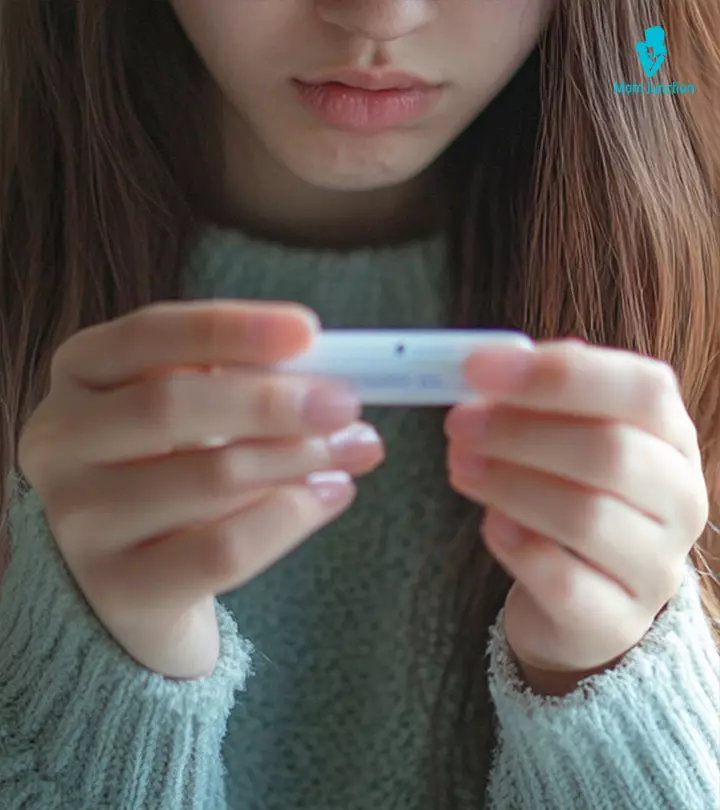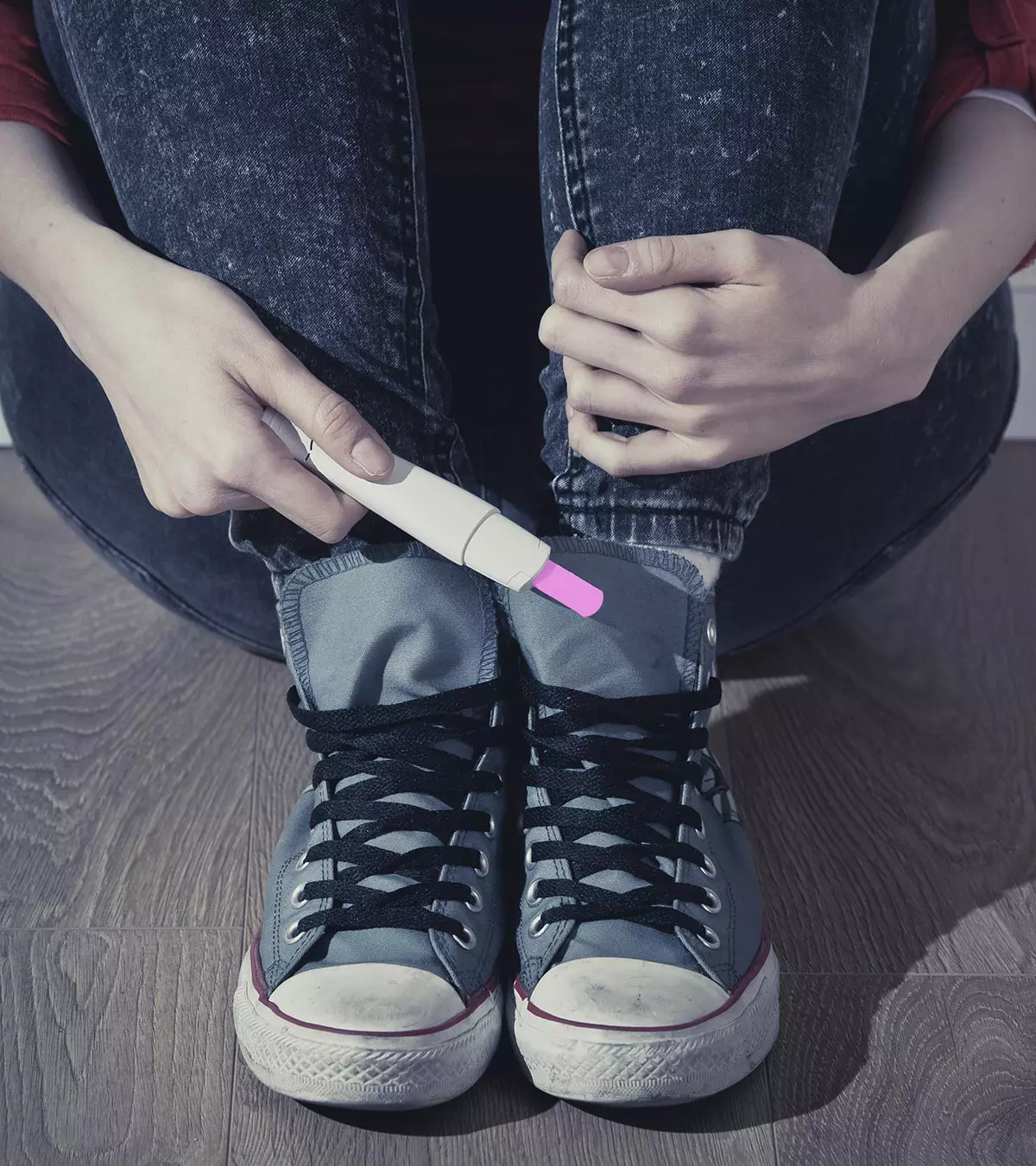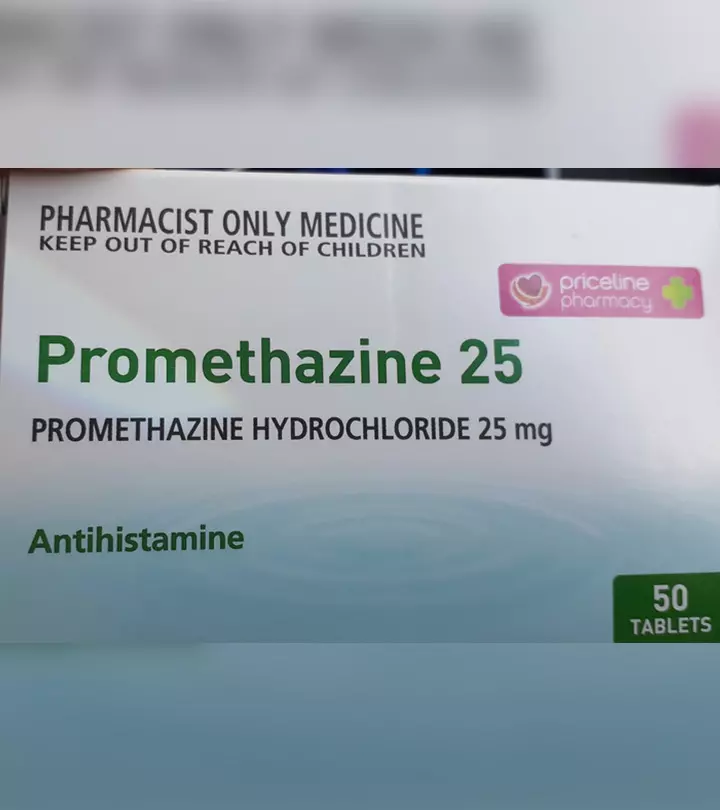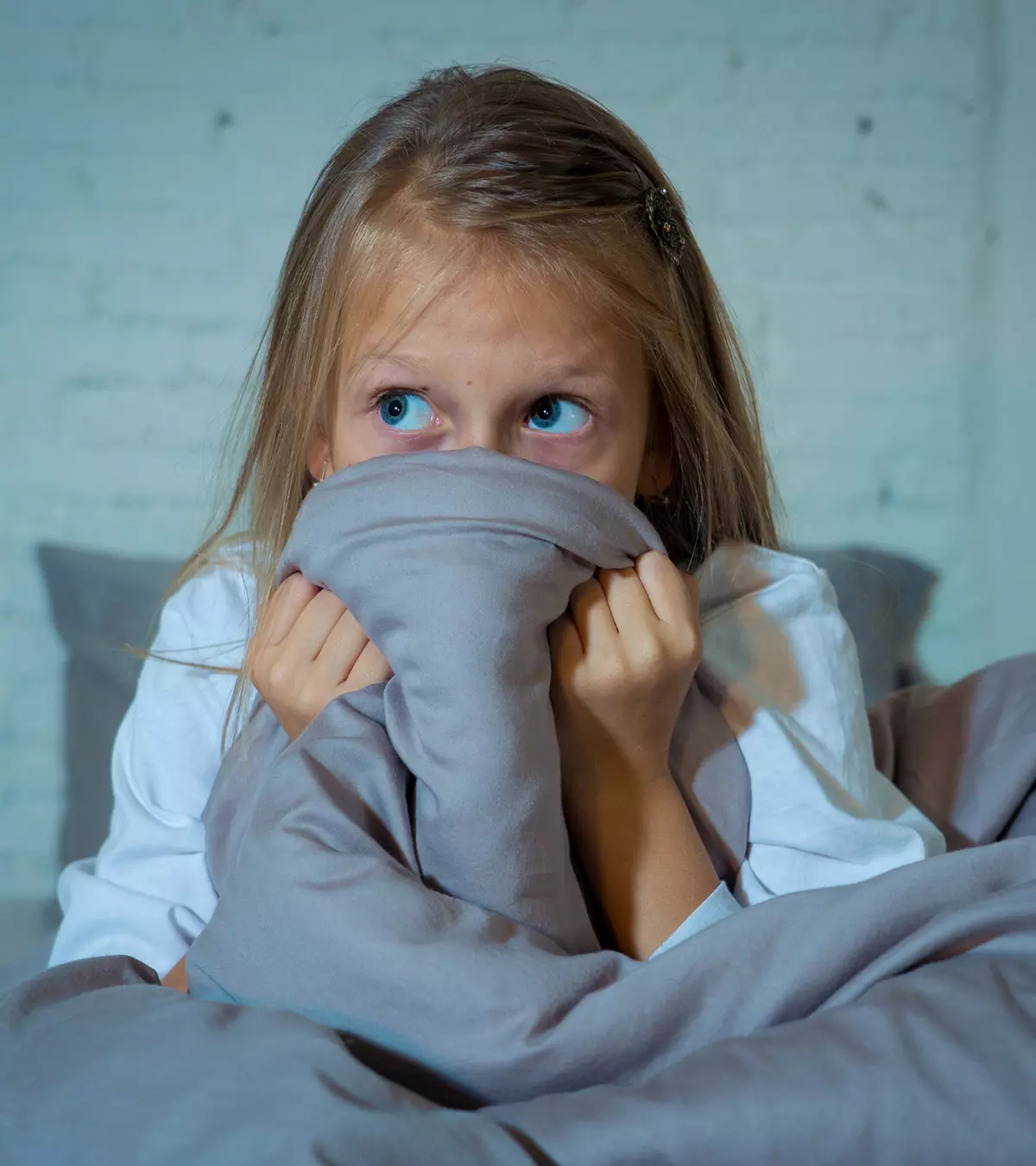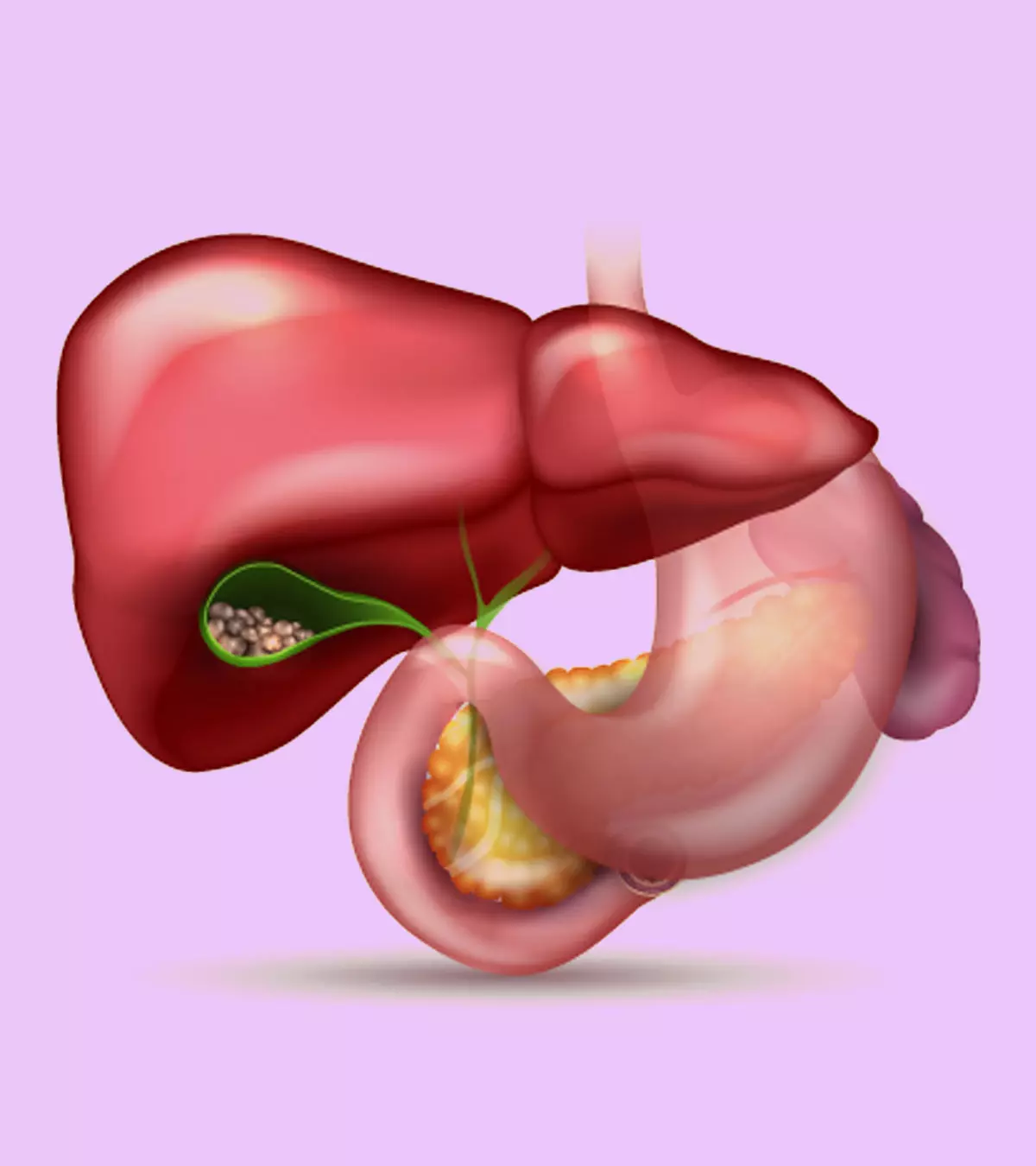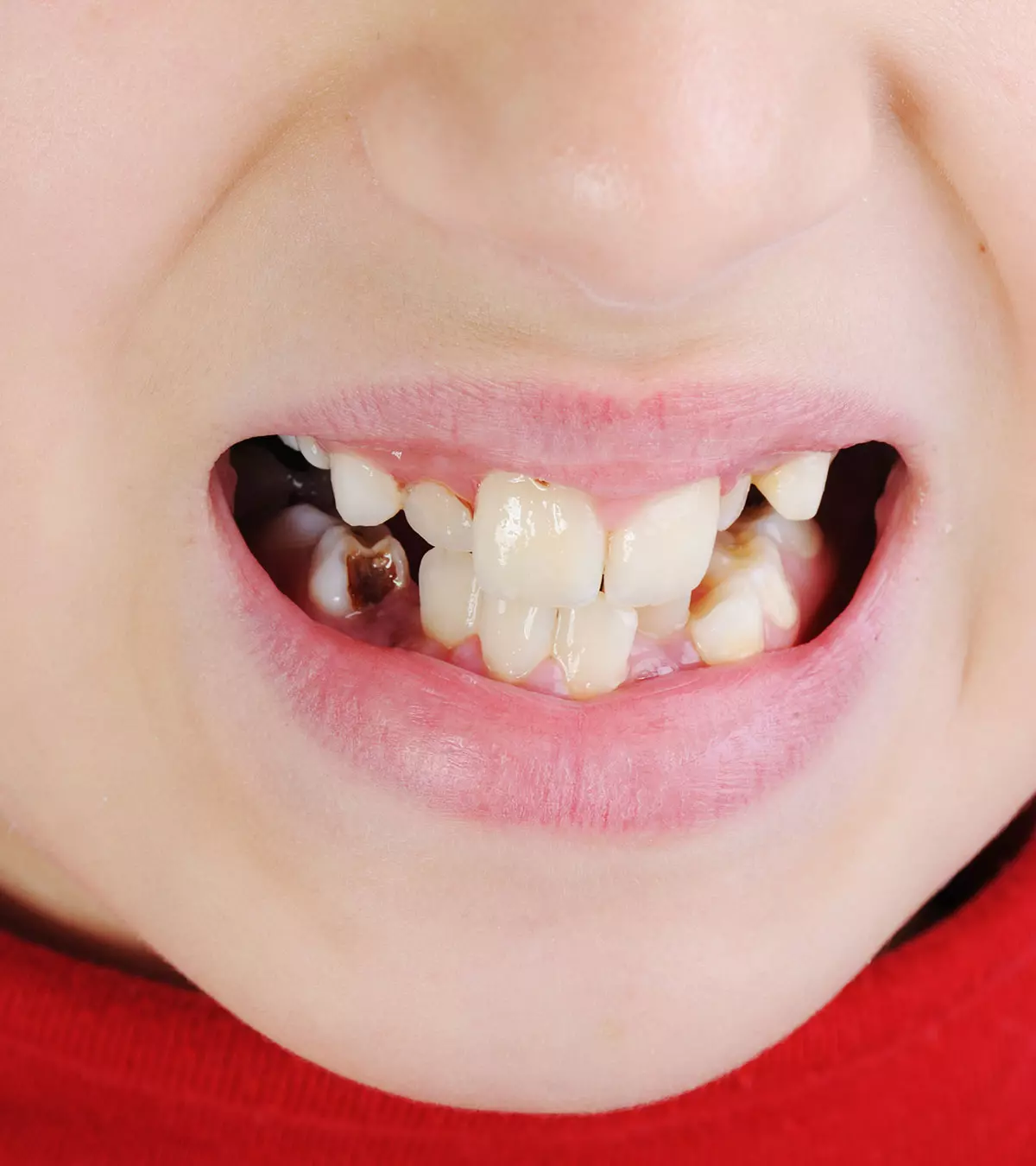
Image: Shutterstock
Tooth discoloration in children is a common dental concern where a child’s tooth or teeth lose their natural white hue, turning creamy ivory, yellow, brown, or gray. Change in tooth or tooth color changes indicate a problem. However, rest assured that not all tooth or teeth color changes indicate a problem. Yet, being a parent, knowing about tooth discoloration in detail can end your apprehensions and help you stay informed about the various reasons for a child’s tooth or teeth to change color. Read this post as we share with you the possible causes of tooth discoloration, its treatment, and effective prevention.

Key Pointers
- Tooth discoloration can be caused by genetics, medications, excessive fluoride, enamel abnormalities, dental trauma, certain diets, and poor oral care.
- The color of tooth stains may indicate the underlying cause, such as enamel flaws, congenital erythropoietic porphyria, or adverse reactions to dental products.
- Secondhand smoking exposure may increase the risk of dental problems in children.
- Home remedies, such as lemon, salt, baking soda, or orange peels, can help alleviate mild tooth discoloration.
Possible Causes Of Tooth Discoloration In Children
It could be either intrinsic (color deposited within inner layers of a tooth) or extrinsic (color on the tooth surface) discoloration (1). Several factors and conditions could cause discolored teeth in children.
- Genetics: Genetics and hereditary defects in dentin formation or enamel could be responsible for intrinsic tooth discoloration. It means that the child will naturally develop yellow, yellow-brown, or blue-brown teeth, depending on the genetic defectiAn inherited medical disorder caused by an abnormality in the genes An example of an inherited tooth condition is Amelogenesis imperfecta. (1).
- Antibiotics: Some antibiotics can cause permanent discoloration of a child’s teeth. For instance, the antibiotic tetracyclineiAn oral antibiotic used to treat bacterial infections and respiratory tract infections is tooth discoloration caused by the antibiotic tetracycline when it is taken by children below the age of eight years (2).
- Fluoride: Excess exposure to fluorideiA naturally occurring mineral found in rocks, soil, and water and used to prevent tooth decay through toothpaste or drinking water with high fluoride content may cause discoloration of the teeth. Fluoride can result in brown spots on the enamel. This condition is called dental fluorosis (3). According to the National Health and Nutrition Examination Survey (NHANES) 2015–2016 survey, 70 percent of children and adolescents in the US had dental fluorosis (25).
 Quick fact
Quick fact- Enamel defect: Sometimes, there could be a defect in the formation of enamel, which is the outermost layer of a tooth. Such defects in tooth development can cause intrinsic staining of the teeth. One example of enamel defects is enamel hypoplasiaiA dental defect where the enamel has not formed correctly or is absent which causes tooth discoloration (4).
- Dental injury: Traumatic injury may cause discoloration of the teeth due to bleeding or due to exposure of dental tissue. Injuries may cause the teeth to become dark gray, yellow, or pink based on the injury (5).
- Food: Some foods with natural color may stain the teeth temporarily. Examples of such foods are tomato and soy sauce, candies, berries, chocolate, pickles, and beets (6). Eating habits, especially consuming a lot of acidic foods and drinks, can wear down enamel and make teeth more prone to stains, leading to discoloration.
- Poor dental hygiene: Not brushing or flossing regularly might increase the plaque stains on teeth and cause tooth discoloration along with bad breath in kids (7).
- Others: There can be miscellaneous reasons for discoloration. For instance, children with asthma, who use inhalers regularly, may have discolored teeth. Frequent dental fillings may also cause the teeth to become discolored (8).
The different causes of discoloration of teeth leave stains of different colors. It is good to understand the various colors of tooth stains.
What Does The Teeth Stain Color Mean?
The common tooth stain colors are yellow, black, blue, brown, and gray (9). Below are the common factors or reasons that may lead to the development of stains (1).
- Yellow or yellowish-brown: Medications, traumatic injuries, intracanal medicamentsiMedical supplements used to eliminate bacteria or inflammation after canal instrumentation , and enamel defects may be responsible for causing yellow, yellowish-green, or yellowish-brown discoloration.
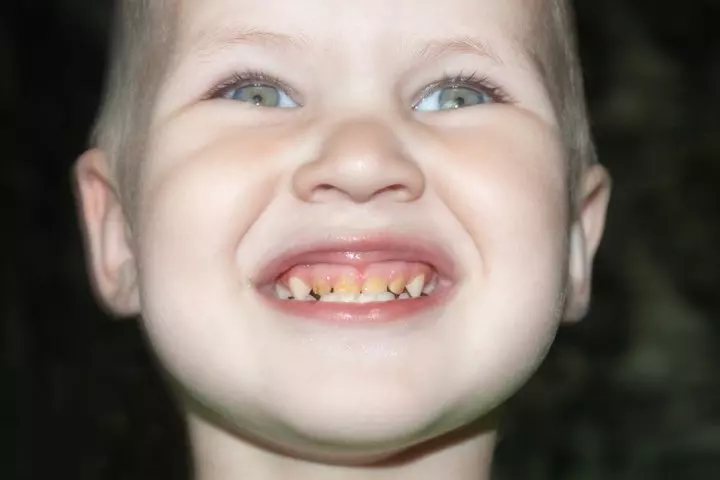
- Red or reddish-brown: It may be caused due to diseases like congenital erythropoietic porphyriaiA rare, inherited disorder found among infants and characterized by blistering and breaking of skin surfaces (rare metabolic disease).
- Orange, orangish-red, or pink: Some of the factors causing such discoloration include chromogenic bacteriaiA type of bacteria responsible for brownish or black stains on the teeth of children (due to poor oral hygiene), root canal cement, or traumatic injuries.
- Green or bluish-green: Children using products with nickel and copper may develop such color. Teeth infected by chromogenic bacteria may also result in such discoloration.
- Gray or grayish-black: These colors could be a result of specific materials such as silver nitrate, lead, or mercury used in dental treatments.
- Black: Iron supplementation, medications, and different materials used in the root canal therapy are a few factors that may cause black stains.
 Research finds
Research findsNatural Remedies For Teeth Whitening For Children
If the discoloration is mild and not due to any medical condition, then you may try these home remedies for discolored teeth in children (10) (11):
- Lemon and salt: Lemon mixed with salt or lemon peel with salt and baking soda can help in whitening teeth. This blend can be applied to the teeth and then brushed. You may also mash the lemon peel, mix it with salt, water, and baking soda and use it as toothpaste.
According to Dr. Scott Cardall, orthodontist from Orem, Utah, “Baking soda only helps remove stains externally from teeth but is ineffective in bleaching the interior of teeth. A few active ingredients, generally with hydrogen peroxide or its derivatives like carbamide peroxide, will bleach teeth internally.”
- Orange peel: As per a research study, orange peel extracts are known to be useful as teeth whiteners. Rubbing the teeth with dried orange peels may help in whitening the teeth. However, the best whitening effect may be obtained using a five percent concentration of tangerine peel (12).

- Oil pulling: Oil pulling is swirling the oil in the mouth to rinse the teeth. Oil pulling can be done with extra virgin coconut oil to whiten teeth. However, research doesn’t specify its effectiveness for kids (13).
- Banana peel: Studies indicate that banana peels tend to have a similar whitening effect as orange peel (26).
- Charcoal: Charcoal is often used in toothpaste formulations as a whitening agent due to its ability to bind to remove toxins. However, it must be used in limitation as charcoal is highly abrasive on the enamel. Using it in excess may cause the teeth to turn yellow.
Ashby Duval, a mother, in her blog on making toothpaste at home, writes, “if you or your child have significant yellowing, charcoal can help a lot. I break open a capsule (this you can get at any health food store or drug store) and use it after brushing for even more whitening power (i).”
Natural remedies may or may not work. If the discoloration of your child’s teeth is severe, lasts for several weeks, and is accompanied by other gum or teeth problems, then promptly see a dentist.
Treatment For Discolored Teeth In Children
The treatment of discolored teeth in children depends on the extent of discoloration. If the dentist/doctor can identify the cause, then they might recommend controlling or curing it. For instance, if teeth discoloration is due to an ailment, then the doctor will aim to cure the condition so that discolored teeth are treated as well.
A dentist may suggest restoring the teeth to the original color through any of the following methods.
- Composite resins: These are paste-like resins applied to the discolored sections of a tooth to restore the color. The restoration with this composite bonding process could be partial or complete, depending on the extent of tooth discoloration (13).
- Teeth whitening strips: A strip of gauze soaked in hydrogen peroxideiA chemical compound usually used as a bleaching agent or an antiseptic and placed on the discolored tooth may help restore normal color. This process may require multiple sittings (15).
- Dental bleach: A dentist could use various compounds to bleach discolored teeth. The bleaching substance and method of bleaching depend on the color and extent of the stains (16).
 Experts say
Experts say- Dental bonding: In this cosmetic treatment process, the dentist applies dental repair material on the discolored tooth and then treats it with UV light or heat. It makes the dental repair material stick to the teeth, thus covering the discolored section of the teeth (14).
- Whitening agents: If the discoloration is minimal, then the dentist may prescribe tooth whitening rinses, chewing gums, whitening floss, and gels for use at home. Such substances should be used only on the dentist’s advice (17).
Ways To Prevent Tooth Discoloration In Children
Following some simple measures and habits may help prevent stains on a child’s teeth (27) (28).
- Maintain oral hygiene. Encourage children to practice oral hygiene for whiter and healthier teeth. Brushing twice a day, flossing once daily, and rinsing with mouthwash daily help fight plaque.
- Limit foods and beverages with additives and sweeteners. Limit juices, high-fat milk, sports drinks, chocolates, candies, and sugary foods to prevent stains by minimizing the risk of cavities. Carbonated sodas contain color additives and sweeteners that can corrode the enamel, causing tooth discoloration. Some other foods that may cause staining are berries, tomato sauce, beets, and grapes (18). A child should rinse their mouth with water after eating these foods to prevent extrinsic stains. Also, it is best to avoid putting kids to bed with a bottle as this can cause cavities and other dental issues.
- Maintain a healthy diet and hydration. Foods rich in vitamin C may whiten teeth. Strawberries, broccoli, kiwi, and whole-grain may also help (19). Also, fiber-rich foods such as beans, spinach, and other leafy greens may naturally clean the tooth by neutralizing acids and increasing saliva production. Consuming adequate water may rinse off the bacteria and protect the teeth. It may even improve saliva production.
- Use straws and sugar-free gum. Drinking beverages with straws may help avoid staining teeth. Similarly, chewing sugar-free gum may rid the oral cavity of food particles and neutralize the acidity levels in the mouth.

- Have routine dental checkups. The American Academy of Pediatrics recommends routine checkups with the dentist and dental cleaning once every six months. It can help keep teeth healthy and white.
- Avoid teeth grinding. Children often tend to grind their teeth to express their emotions. This may cause their enamel to erode away, leading to discoloration.
- Check your water supply for fluoride. Advising on the prevention of tooth discoloration, Ronald Perry, director of the Gavel Center for Restorative Dental Research, says, “Drinking water supplies in some parts of the country naturally contain significant amounts of fluoride. Very low amounts of fluoride are added to many other water systems as a public health measure to help control tooth decay, especially in children. If your water system is fluoridated, you and your children may not need to use fluoride rinses—ask your dentist about this (28).”
Discolored teeth in children isn’t a serious dental problem. Hereditary defects in dentiniA layer of yellowish tissue located below the enamel to support its structure formation, using antibiotics, drinking colored beverages, and exposure to fluoride through toothpaste and drinking water are some of its common causes. When a tooth gets discolored, it can have stains of different shades, such as black, green, yellow, and grey. Depending on the severity of discoloration, lemon and salt mixture application and oil pulling are a few natural home remedies that might lighten stains. Maintaining optimum oral hygiene, consuming enough water, and visiting dentists regularly are simple ways to prevent stains on a child’s teeth.
Frequently Asked Questions
1. What are the long-term effects of discolored teeth in children?
Discoloration of teeth is a significant cosmetic problem that can affect an individual’s attractiveness and psychosocial appeal. This is especially true when an anterior tooth discoloration affects their smile and self-esteem, causing anxiety (22). In addition, discoloration is linked with dental conditions, such as gum and tooth decay, cavities, and gingivitis, which impact overall dental and oral health in the long term (23).
2. Which toothpaste is best for preventing discolored teeth in children?
Children can use American Dental Association-approved fluoride toothpaste in minute quantities to avoid dental problems (24). Also, the toothpaste should be gentle and have a low fluoride content. In addition, if they have been diagnosed with tooth discoloration due to fluoride, it is best to use American Dental Association-approved non-fluoride toothpaste in the same quantity.
3. Is there a link between discolored baby teeth and discolored permanent teeth?
No, there is no link. If your child takes good care of their teeth, there’s no need to worry. This kind of discoloration is normal and happens because adult teeth have more of a dense inner tissue called dentin compared to baby teeth. The outer surface of the teeth, called enamel, is see-through. Sometimes, the dentin shows through and looks more yellow and bigger compared to the small, light-colored baby teeth. As your child’s permanent teeth continue to grow, they will gradually become lighter in color. As the baby teeth fall out and are replaced by permanent teeth, their smile will become more even and consistent in appearance.
4. Can thumb sucking or pacifier use cause tooth discoloration in children?
No, thumb sucking or pacifier use does not directly cause tooth discoloration in children. However, using pacifiers and thumb-sucking can introduce harmful bacteria into the mouth, increasing the chances of tooth decay. Some parents may dip the pacifier in sugary substances, which can also cause acid production and tooth enamel erosion, leading to decay.
Infographic: Ways To Prevent Tooth Discoloration In Children
Tooth discoloration may indicate an underlying oral health emergency, hamper your child’s confidence, and interfere with their relationships with peers and elders. So to prevent all of these, it is advisable to adopt certain practices and avoid discoloration. Explore the infographic below to learn about the preventive measures.
Some thing wrong with infographic shortcode. please verify shortcode syntaxIllustration: Causes Behind Discolored Teeth In Children And Treatment

Image: Dall·E/MomJunction Design Team
You may wonder why your child’s permanent teeth are yellow and have numerous other related questions. Watch this informative video to learn why this happens and how to keep your child’s teeth healthy and white.
Personal Experience: Source
MomJunction articles include first-hand experiences to provide you with better insights through real-life narratives. Here are the sources of personal accounts referenced in this article.
i. Natural Teeth Whitening—For Your Child and You.https://thegritandgraceproject.org/motherhood/how-to-whiten-your-childs-or-your-teeth-naturally
References
1. Manuel ST, Abhishek P, and Kundabala M; Etiology of tooth discoloration – a review; Nigerian Dental Association (2010)
2. Tetracycline; C. S. Mott Children’s Hospital Michigan Medicine
3. Fluoride and Children; Children’s Hospital of Philadelphia
4. Sheenam Kansal et al.Discoloration of Teeth: A Literature Review;International Journal of Health and Clinical Research (2025).
5. S. K. Panchal; Tooth discoloration after traumatic injury: A diagnostic challenge; Oral Health and Dental Management
6. What causes discolored teeth and is there any way to cure or prevent staining?; Tufts University (2016)
7. Oral Health; California Childcare Health Program the University of California (2006)
8. Childhood Tooth Discoloration: Why Is Your Child’s Tooth Changing Color?; Apollo Dental
9. M. Baharvand; Colors in tooth discoloration: A new classification and literature review; International Journal of Clinical Dentistry (2014)
10. A. Wray and R. Welbury; Treatment of intrinsic discoloration in permanent anterior teeth in children and adolescents; International Journal of Paediatric Dentistry
11. Ana Maria;Home remedies for white teeth; Academia
12. F. Pratiwi et al.;Citric acid compounds of tangerines peel extract (Citrus reticulata) as potential materials teeth whitening; Journal of Physics (2016)
13. V. Saravanan et al.;Effects of Coconut and Olive Oil on Tooth and Restoration – in vitro study – Myth(oil)ogy?; Journal of Academy of Dental Education (2018)
14. Dental Bonding; Cleveland Clinic
15. K. Donly; Tooth Whitening in Children and Adolescents; Journal of Esthetic and Restorative Dentistry (2005)
16. Policy on the Use of Dental Bleaching for Children and Adolescent Patient; The Reference Manual of Pediatric Dentistry (2019)
17. F. F. Demarco, S. S. Meireles, and A. S. Maso; Over-the-counter whitening agents: a concise review; Ethestic Dentistry(2009)
18. 10 Foods that Stain Your Teeth: What Foods and Drinks Make Your Teeth Yellow?; Dentaly.org
19. The best foods for a healthy smile and whole body; College of Dentistry (2018)
20. Fluoride During Childhood; Healthwise
21. Takashi Hanioka et al.; Association between secondhand smoke exposure and early eruption of deciduous teeth: A cross-sectional study; Tobacco Induced Diseases
22. O. Ibiyemi and J.O. Taiwo;Psychosocial Aspect Of Anterior Tooth Discoloration Among Adolescents In Igbo-Ora, Southwestern Nigeria; NCBI
23. Are Discolored Teeth a Health Concern?; Brimhall Dental Group
24. Keeping Your Child’s Teeth Healthy; Nemours
25. Haitao Dong et al.; Associations of low level of fluoride exposure with dental fluorosis among U.S. children and adolescents, NHANES 2015–2016; NCBI
26. Archana P Betur, Raju O S, and Roopa K B; Natural fruit peels as teeth whitening agents on primary teeth an in vitro study; International Journal of Ayurvedic Medicine
27. Tooth Discoloration; Cleveland Clinic
28. What Causes Discolored Teeth and Is There Any Way to Cure or Prevent Staining?; Tufts University
Community Experiences
Join the conversation and become a part of our nurturing community! Share your stories, experiences, and insights to connect with fellow parents.
Read full bio of Dr. Shailesh Shenoy
- Dr. Scott Cardall is an orthodontist based in Orem, Utah. He attended the Harvard School of Dental Medicine and did his Orthodontics residency program at Oregon Health & Science University.
 Dr. Scott Cardall is an orthodontist based in Orem, Utah. He attended the Harvard School of Dental Medicine and did his Orthodontics residency program at Oregon Health & Science University.
Dr. Scott Cardall is an orthodontist based in Orem, Utah. He attended the Harvard School of Dental Medicine and did his Orthodontics residency program at Oregon Health & Science University.
Read full bio of Dr. Ritika Shah
Read full bio of Swati Patwal
Read full bio of Ghazia Shah






